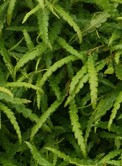 This handsome low-growing suckering shrub is a native of Northeastern United States where it is found growing in poor gravelly or sandy soil along roadsides and similar waste areas. The plant forms a dense mound of multiple stems with spreading branches that are shiny or bear resin dots. The deciduous leaves are up to four inches long, light green at first changing to dark green as they mature, but are not attractive in autumn. They are deeply notched, fern-like and aromatic when crushed. Small yellow green male and female flowers are produced in catkins on the same plant in spring. The fruits are nutlets that are produced in clusters. The roots are able to fix nitrogen which helps the plant grow in poor soil and makes it useful for erosion control in difficult sites. Sweetfern is difficult to transplant and does not compete well with other plants in good soil. Not suitable for zones 7 and warmer.
This handsome low-growing suckering shrub is a native of Northeastern United States where it is found growing in poor gravelly or sandy soil along roadsides and similar waste areas. The plant forms a dense mound of multiple stems with spreading branches that are shiny or bear resin dots. The deciduous leaves are up to four inches long, light green at first changing to dark green as they mature, but are not attractive in autumn. They are deeply notched, fern-like and aromatic when crushed. Small yellow green male and female flowers are produced in catkins on the same plant in spring. The fruits are nutlets that are produced in clusters. The roots are able to fix nitrogen which helps the plant grow in poor soil and makes it useful for erosion control in difficult sites. Sweetfern is difficult to transplant and does not compete well with other plants in good soil. Not suitable for zones 7 and warmer.
Type: Deciduous shrub
Outstanding Features: Attractive foliage; tolerates drought, wind, wet and infertile soil
Form: Low mound
Growth Rate: Slow
Bloom: Small yellow-green male and female flowers produced on the same plant in spring
Size: 2-4’ H x 4-8’ W
Light: Full sun to part shade
Soil: Poor, gravelly, sandy, dry to wet, acidic
Hardiness: Zones 3-6
Care: Low maintenance
Pests and Diseases: None of significance
Propagation: Root cuttings, young stem cuttings, division.
